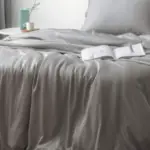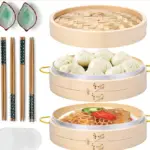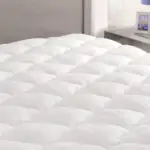Bamboo is a material that is becoming increasingly popular within homes, as it is now becoming a common type of flooring, amongst other things.
Bamboo looks beautiful and elegant, and it can be very smooth to the touch too, which is why so many people favor it.
But an important question you have to ask yourself is whether bamboo is waterproof or not, especially if you’re using it within your home, and particularly, as flooring!
The truth is, that as bamboo is a type of grass, it is a lot more water-resistant than other materials used for flooring, particularly hardwood.
However, bamboo is not waterproof. This means that bamboo can suffer from water damage if exposed to certain amounts of water, and the bamboo can swell up, warp, distort in its shape, and eventually become discolored or stained.
In fact, not only is bamboo not waterproof, but it is also quite sensitive to humidity and changes in the water around it, meaning that it will change depending on the humidity around it, and eventually, it could crack!
Also, as bamboo contains quite a lot of starch (as it is grass, after all), it can become infected with fungi, mold, and all sorts of insects, if it is exposed to humidity and water for long periods of time!
So…how come it is being used as flooring in homes?
Well, the bamboo used in homes is treated bamboo, and the treatment it receives essentially makes it slightly more waterproof and resistant so that it doesn’t have these problems.
In fact, most bamboo flooring is treated with a sealant, so that it becomes completely resistant to water!
Types Of Bamboo Flooring
As we mentioned, bamboo is mainly being used within homes nowadays as a type of flooring. But there are also several different types of bamboo flooring, depending on how the manufacturing process takes place.
Here are the main different types of bamboo flooring:
- Stranded bamboo:
This type of bamboo flooring is manufactured by shredding the bamboo stalks until they are small strands, then compressed through the use of heat and resin binders into sheets. After that, these sheets are cut into planks and used as flooring.
This type of bamboo flooring is considered to be premium and very high-quality, and the bamboo can be made into different colors, depending on the preference of the customer.
- Horizontal bamboo flooring:
This type of bamboo flooring is manufactured by cutting the strands of bamboo into thinner strips, and these are then glued together to form the planks for the flooring.
The stalk fibers remain visible, which is why this bamboo flooring is described as having “grain”, and it is a very appealing appearance. However, this bamboo flooring is not as durable as other options and is made to be cheaper and more accessible.
- Engineered bamboo flooring:
This type of bamboo flooring is manufactured by bonding thin layers of bamboo onto plywood or MDF core.
The result is quite similar to engineered hardwood, especially as they are both installed in the same way. It is the cheapest form of bamboo flooring, making it the most popular, but this also means that it is the least durable, and therefore not regarded as very high quality. Also, it can’t be refinished to taste.
This type of bamboo flooring is also the most common one to be scratched and damaged over time, making it less and less visibly appealing as it is used.
Should You Get Bamboo Flooring?

Bamboo that is properly treated for being used as flooring, is made to be completely water-resistant, and although bamboo isn’t originally waterproof, it is still more resistant to water than hardwood, which is why it is a good alternative.
But…should you get bamboo flooring?
Well, we can’t tell you what to do in your own home, but we can instead give you some pros and cons to bamboo flooring so that you can make up your mind knowing the basic facts!
Here are the main advantages and disadvantages of bamboo flooring:
Pros
- It is eco-friendly:
This is because bamboo is a renewable resource, with bamboo stalks growing incredibly fast, and not suffering any decrease in growth or amount despite being harvested.
- It is very easy to maintain:
In fact, bamboo can be kept clean and in good quality with very little effort, as all it takes is some regular sweeping and vacuuming, and a mop every now and again. And if your bamboo flooring has a grain to it, it will also help hide dirt better, so that it always looks relatively clean!
- They can be refinished with ease:
Most types of bamboo flooring can be easily refinished, so that they are smoother and more visually appealing, and fit into the style and aesthetic of your home more conveniently.
- They add real estate value:
Bamboo flooring is very similar to hardwood in almost all aspects, but it looks a lot fancier, and there’s something about saying “bamboo flooring” rather than “hardwood flooring” that makes your home go up a level, you know?
It is no secret that bamboo flooring can add real estate value, so it increases the value of your home!
Cons
- It gets scratched easily:
One of the biggest downsides to bamboo is that it is incredibly prone to get scratched and damaged. So if you clean it too roughly, or something falls on it, or you drag furniture over it…the likelihood is that it will have a big visible scratch or dent to show for it.
- It is vulnerable to humidity, especially if not treated right:
Bamboo is not waterproof, but when made into flooring, it received a treatment that makes it water-resistant.
However, bamboo is still quite vulnerable to humidity, and if you don’t maintain it properly, it could end up becoming home to mold, fungi, and multiple different types of insects.
On most occasions, this won’t happen, but if you live somewhere with high levels of humidity, it will be more prone than other types of flooring.
- It is not as durable as other flooring options:
High-quality expensive bamboo flooring can be quite durable, but the regular affordable bamboo flooring is not so much, and therefore it does not last as long as other types of flooring.





